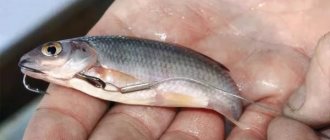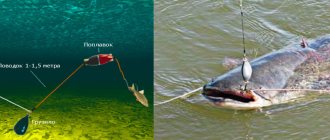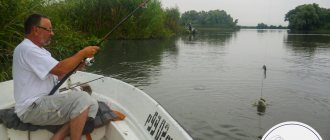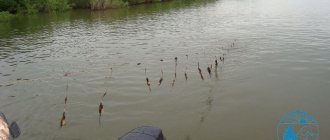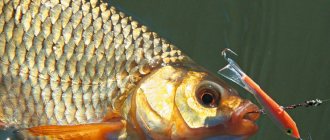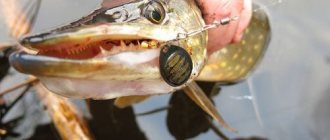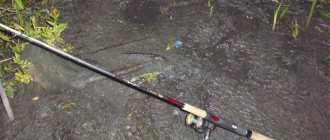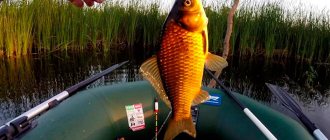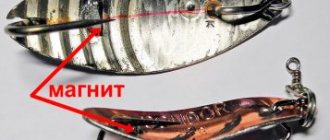Good day. Today, my dear fishing friends, during the active fishing season, I want to touch upon such a common topic for many spinning anglers as: fishing with a spinning rod from the river bank.
Of course, fishing from a boat involves significantly more opportunities, however, it also requires the possession of some spinning fishing skills, and the presence of this very boat, and then there’s already: a boat motor, a vehicle, and off we go.
When fishing on the shore, everything happens much simpler.
There is no need for an echo sounder, there is no need to make ultra-long or ultra-precise casts to the very edge of aquatic plants or exactly to the place where a predator is fighting, just walk along the shore and slowly fish the places you like, which both seasoned anglers like and is quite capable of for beginner anglers.
Catching predators and semi-predators in shallow waters
In this article I will deliberately not consider catching a rather rare specimen - catfish; I will also ignore pike perch, which in most cases requires large expanses of reservoirs and, accordingly, a fishing boat, but I will consider as possible prey the coastal spinning fish that are most often found in our rivers for perch and pike, as well as, less commonly, semi-predatory pike perch.
We will consider catching the above-mentioned fishing subjects in shallow waters;
- with the presence of rare grass,
- reed thickets,
- occasional sandbanks,
- and often present snags or isolated trees protruding from the water.
First, let's look at which of the existing spinning baits should be used for fishing in the indicated conditions.
If the fishing area is shallow within one meter, then the best choice would be -
- surface wobblers,
- spinners,
- much less often is lightly loaded or unloaded silicone.
I consider the use of oscillating spoons at such shallow depths inappropriate. If the depth is more than a meter or more, then it is quite reasonable to add to the rotators:
- all kinds of loaded silicone,
- wobblers with appropriate immersion depth,
- and spinners.
Now let's look at all of the above fishing lures in more detail. Let's start with the classics - oscillating spoons. Very often, in places where the depth is more than one meter, the pike predator, from the whole variety of baits, chooses a spinner as an object for attack, especially at low water temperatures or during periods of low activity.
There is a certain difficulty in correctly guiding oscillating spinners: at different speeds, the play of the spinner varies significantly.
For example, if the fishing speed is too low, the spoon will simply slide through the water column without producing attractive vibrations for the predator; with slight acceleration of the wiring, we get somewhat chaotic oscillatory movements; If you accelerate the movement even more, then rotational movements will be added to the oscillatory movements.
Therefore, some difficulties arise with the selection of the optimal speed of the spinner, the determination of which is carried out, in fact, intuitively.
Fishing Features
Live bait is a representative of a small fish species that serves as live bait for larger and more predatory species. Not only fry, but also adult small and medium-sized fish can act as live bait.
Fishing with live bait becomes especially popular in late autumn, winter and early spring - during periods when the amount of food in the water decreases and the fish bite well on natural bait.
[THERE IS AN ANSWER] How to catch pike with live bait in the summer?
Both river and lake species of fish are used as live bait, the most common of which are presented below.
- Rudd. This fish is distinguished by the fact that it is capable of maintaining mobility for a long time, already being baited on a hook. This behavior attracts individuals of large species and ensures a good catch.
- Bleak. This fish is often used to catch large perch and pike, which quickly rise from the bottom to feast on tasty prey.
They catch bleak both from a boat and from the shore, using a regular fishing rod.
- Perch. The fry of this fish attract pike and pike perch well, but do not have a long survival time on the hook and quickly lose mobility.
- Crucian carp. This fish is characterized by long survivability and long-term mobility on the hook. Crucian carp is good for catching pike and other types of large predators.
- Top melter. This type of fish lives in the upper layers of reservoirs and is very unpretentious to environmental conditions. A rotan, large perch and pike are excellently caught using a topwater fishing rod.
- Loach. These fish are considered an excellent delicacy for bottom predators - catfish, burbot and pike. They live in muddy sediments of water bodies. In bad weather, the loach floats a little higher, where it is easily caught with a donkey with wire or other traditional gear.
The loach retains the appearance of living prey for a long time, and therefore its use as bait is very effective.
- Gudgeon. This fish is good as bait for pike and pike perch, but is unable to remain mobile for a long time in warm water. However, when immersed in the lower layers of a reservoir, where the temperature is significantly lower, it will remain active a little longer.
- Ruff. It is good to catch burbot with this live bait, but the ruffe, like the gudgeon, does not like warm water and dies quickly.
This point should be taken into account when planning fishing with ruff.
For pike fishing, it is better to use double or treble hooks, depending on the size of the bait. It is better to take sizes 8-12.
Options for wiring baits
Let's try to consider the wiring of the oscillating spoons of the baits themselves by weight.
For special pike fishing at shallow depths or over fields of underwater vegetation, light spoon spoons are best suited. If the retrieve speed is too high, such spoons immediately come to the surface and lose their attractiveness to predators.
The optimal options for wiring these baits are uniform and stopping wiring. With uniform wiring, you need to lead the bait at the highest possible speed, but without allowing it to reach the surface. If you move the bait too slowly, it will not work.
In a fishing place where the depth exceeds a meter, it would be better to carry out the wiring with stops. If fishing takes place in a place “rich” in plants, then it is better to equip the spoon with a double with hook tips pointing upward.
When fishing, such a spoon can be placed on the bottom surface, and after touching the latter, you need to perform a long, smooth pull, and then pause again. This type of fishing works best when fishing with narrow spoons, which begin to rotate when they fall.
But the most common type of oscillating spoons are medium-weight lures. They can also be carried out in the two above-mentioned methods, but it is precisely this type of bait that requires the fisherman to have an intuitive feeling of the optimal specified speed of their movement.
When retrieving, these lures should under no circumstances go into a tailspin, but should not simply dangle at the end of the fishing line. They have a rather limited range of acceptable speeds. Of course, even with not particularly high-quality wiring, the spoons will still remain attractive to predators due to their similarity to forage fish.
But the best thing would be to find out the most optimal speed immediately before fishing, for which you need to move the spoon near the shore and remember when it will play most attractively, in your opinion.
What kind of fish can you catch?
When fishing at sea, you can catch completely different species of individuals. It is quite difficult to predict what kind of fish you will be able to get today. Often found at sea:
- sea urchin;
- cod;
- mackerel;
- horse mackerel;
- mackerel;
- red mullet
In less salty waters or at river mouths you can catch:
- pike;
- salmon;
- pike perch;
- perch
The methods of catching fish can also be different, but you need to choose the right bait. Fishermen with extensive experience even hunt sharks in the sea. To catch such an aggressive predator, you will need to show cunning, as well as withstand the physical stress that will undoubtedly arise when fighting it.
This fish is caught from a boat or yacht. Fans looking for small sharks can find them on the shores of Bulgaria or Crimea. Larger specimens live off the coast of Africa. When fishing, you need to take care of the boat and the choice of spinning rod in advance. It does not have to be long, but the main thing is that it is strong and elastic.
In general, action is the speed at which the bent end returns to its original position. The higher the speed, the further you can throw the bait. Light bait up to 10 grams can be cast far to outwit the smartest fish. It will also be convenient to cast heavy baits far, but this is not always appropriate.
You should opt for a spinning reel. It’s better to buy expensive models for spinning rods, but to start with, it’s better to stick with cheap models. They break more often, but replacing them is easier and simpler than repairing them.
It is customary to distinguish 5 types of fishing rods
1. Float - suitable for catching any fish in any body of water. They, in turn, are divided into 4 types:
- Flywheels - have a low price, simple design and are easy to use. Ideal for fishing on the shore.
- Plug-in - designed for fishing in strong currents or on an overgrown bank.
- Match fishing is an option for experienced fishermen. Designed for fishing with minimal or no current.
- Bolognese are the simplest and most versatile fishing rods. Used near the shore for long casts.
2. Spinning rods - designed for catching predatory fish. 3. Carp - created specifically for carp fishing, as its behavior is unpredictable. 4. Feeder – for bottom fishing. They have a feeder that attracts fish.
Before purchasing, you need to decide where and under what conditions the fishing will most often take place. A quiet lake or pond, or maybe a river with a strong current.
When fishing in a stormy river, it is recommended to choose a telescopic fishing rod. It is compact and easy to repair. When fishing from a boat, it is permissible to use a long, medium-weight rod.
Having listened to the above advice, a novice fisherman can consider himself prepared from a theoretical point of view. Now it's a matter of practice.
Laskir.
Sea float rod
Sea float rod
Catching sea fish with a float rod
Red mullet or red mullet.
A fixed float has good sensitivity and light weight, but it can easily break off, rotates at a depth equal to the length of the rod and is of little use if the depth does not match the length of the rod.
The best bait for red mullet is the nereid, a red-green sea worm. A piece of worm should be placed on the hook. With a good bite, the red mullet will also take an ordinary earthworm or dungworm, which is also planted not entirely, but in small pieces. Sometimes red mullet pecks on a piece of raw shrimp meat and sea fleas.
Scorpionfish (sea ruff).
It is caught from the shore or structures protruding far into the water, at shallow depths with a rocky bottom covered with brown algae. It is well fished from a boat using onboard float rods at depths of up to 30 m.
Lavrak.
The effectiveness of fishing is increased by bait placed in a bag with small cells, from where food particles will be washed out even with a slight movement of water. The feeder is held at the bottom by a weight. For bait, crumbles of finely chopped fish, shrimp, crab meat, fish marc, etc. are suitable. Scented extracts are also used to serve as additional bait.
Tips for fisherman: Sea fishing in Murmansk for cod - Tips for a beginner
Mullet.
Various types of mullet can be caught well using a float rod. It is better to fish from the shore in the early morning, when schools of mullet in search of food sometimes follow near the very edge of the water. When fishing with a fishing rod with a blind rig, it is imperative to camouflage yourself behind cover. This could be some kind of coastal structure or a large boulder. Good places are port berths, hulls of ships, boats, small yachts, where you can remain unnoticed.
Usually, when fishing for mullet, they use tackle designed for long-distance casting. Mullet is a very cautious fish, and catching it requires the finest tackle. Even for catching large specimens (about 1 kg), they often take fishing line with a diameter of 0.1-0.12 mm, because Mullet sees well in clear water. In places where the water is somewhat cloudy, you can use a fishing line with a larger diameter (0.25 mm). The nozzle is placed approximately 10-15 cm from the bottom. In ports, mullet often feed at mid-water, so the descent should be appropriate.
The mullet bite is sharp, sometimes the float immediately goes under the water, and sometimes it jumps. A fishing rod left unattended can be jerked sharply and carried out to sea.
Laskir.
Sea crucian carp are caught both from the shore and from a boat. The fishing rod rig should be thin (line -0.14-0.15 mm, leash - 0.1-0.12 mm) with a sensitive (1-2 g) float. The bait is a piece of shrimp, sea worm or mussel meat.
Goby.
Wrasse or Zelenukha.
Horse mackerel.
Shemaya.
It is caught in the upper layers of water with a fishing rod designed for long-distance casting, equipped with a self-loading float. The main line is 0.2-0.25 mm, the leader line is 0.12-0.18 mm. The bait used is insects, crayfish meat, mussels, shrimp, and sea worm. It likes to feed on extensive shallows, so the bait must be cast at a distance of up to 20 m from the shore. Good places for fishing are where small rivers flow into the sea.
Gorbyl.
Garfish.
In addition, the fishing rod can be equipped with a float with a built-in sinker, which makes it easy to make long casts when fishing from above. A rigging option is also possible when a weighted float is tied to the end of the fishing line, and the leash is located a meter away from it (Fig. 3).
The best bait everywhere is shrimp meat. The Baltic garfish also really likes a strip of freshly caught herring meat. If the bite is sluggish, the hook must be done with a long pause, when the bait is in the corner of the fish’s mouth.
The most productive fishing is in early spring, when small flocks of garfish walk near the shore. Walking fishing: moving along the surf, you periodically repeat casts.
Sea pike perch.
Sometimes it is caught with live bait float rods at depths of 6-10 m. At greater depths it is caught from a boat using an onboard fishing rod. The lead line must have a diameter of at least 0.4 mm. Hooks are nickel-plated or tinned, long-shanked, No. 8-10. Small fish (anchovy, sprat, red mullet, etc.) are used for bait. Good places for fishing are located near the mouths of rivers flowing into the sea, in areas with dense clay soil.
mackerel
Fished with float rods throughout the day. The best bite happens in the morning. You can fish from a boat, coastal rocks, piers, piers and breakwaters, at a depth of 3-10 m. The bait is small fish or pieces of fish. In the Black Sea it appears in the Kerch Strait area in May-June. The equipment is the same as for catching garfish.
polar shark
The sharp sound of a rattle notifies that a bite has occurred. After it becomes monotonous, you should make a fairly powerful hook. The shark’s first jerks are the strongest—they try to restrain them by forcefully releasing the line. Having taken about 100 meters of fishing line, the shark most often stops. This is where you should start fishing.
The best bait is considered to be live herring, and the tail fin should be cut off so that the bait looks helpless, in addition, this prevents excessive twisting of the line (Fig. 4).
Drift fishing often occurs at very great depths with strong currents, so quick-release sinkers weighing from 100 g to 1 kg are used. Take a leash that is soft, but reliably protects against rubbing with teeth, such as “Steel Silk”. In principle, it is permissible to use leashes made of steel wire. For the largest specimens, a hook No. 18/10 (international classification) is required.
At the final stage of fishing, when the shark begins to walk in circles, it’s a good idea to have an assistant who, when lifting the shark on board, will help unhook the sinker and pick up the fish.
sea fox
Places where you can catch sea fox are found everywhere from Taman to Sochi. In Crimea, many stingrays live in the area of Sudak and the New World. There are places here where there are great depths not far from the shore. The best time to catch sea fox on the Black Sea coast and in Crimea is August and September.
"Russian Hunting Newspaper No. 43.44 - 2002"
Attention!
Kaliningrad Fishing Club” was used as source material
«
For catching crucian carp with a float rod near the shore, a rod of short length (3-5 meters) is suitable, but if your goal is a larger fish, then the length of the rod should be at least 6 and no more than 10 meters. It is convenient to cast such a fishing rod far from the shore.
Seaworthiness of spinning baits
Testing the seaworthiness of bait in your own bathroom, practiced by many spinning anglers, is not suitable in this case. In order to get a good look at how the spinner plays in the water, it needs to be held at a certain distance, giving it room to maneuver, which can be done on a pond by running a couple of meters of line from the reel.
Wiring with stops of an oscillating spoon should be carried out very similarly to the usual step-by-step wiring of jig baits, while the pike reacts to the spoon like an elastic band.
The only limitation to the use of spinners is the relatively shallow fishing depth, no more than 3-4 meters, and even then preferably in the absence of a current. At great depths, the spinner feels much worse than the jig.
And yet, a spoon, compared to a jig, is much more susceptible to snags when moving it near the bottom. But, on shallows with a clean bottom, it works better than a jig, since it produces stronger vibrations and is noticeable from a much greater distance.
Additional attractiveness is given to oscillating spinners by the holes in their body, which make such spinners noise or acoustic.
The heavy spinner spoons currently used include, first of all, castmasters and other similar cuts. Their wiring is radically different from the above. Usually, it is best to drive the castmaster at the highest speed in the upper layer of water.
In particularly strong currents, you can use drift wiring. You can also try using a jerk retrieve, that is, lower the spoon to the bottom of the reservoir, then move it sharply with a sharp and wide swing of the rod, then pause again while touching the bottom. This wiring option has an attractive effect on pike.
How to catch pike with live bait in the summer
In summer, pike are less active compared to spring and autumn, but do not stop feeding at all. She continues to lead an active lifestyle, usually going to the depths and hiding in the thickets.
[THERE IS AN ANSWER] What smells does carp like in summer?
In July, the peak of fat comes, the pike lacks oxygen and its activity drops to a minimum. Catching a large specimen at this time is not an easy task. However, a small pike up to 2 kilograms will still willingly bite near the shore.
To find out where the pike is, you need to sit comfortably on the shore and watch for 30-40 minutes. From time to time, schools of small fish will jump out of the water, escaping from the ruthless hunter.
In summer, the best time for pike fishing is early morning or evening, when the heat subsides, in cloudy and rainy weather. Fishing on a sunny day means leaving without a catch.
You can catch pike both from a boat and from the shore.
From the boat
Fishing from a boat is available almost throughout the open water season. Having a watercraft, an angler can explore any body of water and place mugs and summer baits in the most promising places.
Many people equip their boat with a fisherman’s assistant – an echo sounder. It allows you to examine all the deep places of the reservoir. And, if you find a cloud of food fish, then a predator is somewhere nearby.
From the shore
Homemade stand for live bait fishing
The most ancient way of catching pike is fishing from the shore. To successfully fish from the shore, you need to carefully study:
- habits of representatives of the pike family;
- get acquainted with the types of fish living in the reservoir, so as not to make a mistake with the bait;
- study the shore and bottom features;
- examine snags and thickets.
And only then proceed to installing gear and directly to the fishing itself.
In summer, pike’s favorite places are channel edges, return streams, places with vegetation, and snags. It can also be found where water is mixed and enriched with oxygen. These are mouths, branches in the river, places where streams flow.
We will tell you some of the most basic methods; they can be used at any time of the year. The methods are very simple and do not require serious skills or a lot of gear. We should start with the fact that it is more convenient and easier to fish in shallow water. In this place, the water warms up stronger and faster, and small fish accumulate in large quantities.
Live bait is an integral part of fishing, and accordingly, every fisherman, both beginner and experienced, must be able to catch it. In our article today, we will consider this issue in detail and find out the main nuances that affect the productivity of this matter.
It is used as bait for catching larger and more predatory fish. Both juveniles and adults can be considered live bait. In our area, fishermen most often bait fish with fry, for example roach or crucian carp.
It is considered to be the best natural bait that fishermen are accustomed to. This method is most popular in autumn, winter and spring, at a time when there is less food in the water.
Rotating spoons for shore fishing
Now let's move on to considering rotating spinners. Usually, when fishing on the shore, spinners of no less than No. 0 and no more than No. 2 (less often No. 3) are used. Smaller spoons are mainly used for targeted hunting of white semi-predator, while larger ones are intended, accordingly, for larger fish, the catching of which we will not consider now.
For fishing in conditions of low fish activity, the best ones are No. 1 and No. 0. Usually, a weakening of the bite is logically followed by a decrease in the size of the petal of the spoon, and, accordingly, when the activity of the fish increases, we use spoons with a larger petal size. We act in a similar way in the case of water transparency: with the least cloudy water, we reduce the size of the petal, and vice versa.
The modern fishing industry produces a sufficient number of different rotating spoons, both quite light and with a weighted core. The color of the petal and core is varied, but the best, according to my observations, will be silver with a bright core and red stripes or yellow dots on the petal (in the latter case, an overall black background is desirable). Also, adding pieces of red or yellow cambric (at least for perch), feathers, and synthetic threads to the tee has worked well.
When guiding rotating spinners, their speed should be as low as possible, on the verge of stopping the rotation of the petal. And of course, when casting, the spoon should not catch the bottom of the reservoir or aquatic vegetation.
Also, when selecting spinners, you need to take into account their weight in order to be able to cast the bait at the required distance from the shore. Typically, the most optimal size of spinners, allowing them to be cast far enough and carried most slowly at the very bottom, will be No. 2.
With the exception of perch fish and hunting for some white semi-predator, predatory fish should be looked for near the bottom, so it is to the bottom wiring that you need to adapt.
How the speed of bait movement affects fishing performance
Now about the wiring speed. Which wiring is better: continuous or intermittent? Here the choice should directly depend on the activity of the intended production.
If there is a need to fish as large an area of a reservoir as possible in a relatively short time, then the wiring should be uniform.
Uneven wiring for classic spinners does not represent a complete stop of movement, but a slowdown or acceleration of the speed of movement of the bait.
The greatest skill is retrieving the blade, when we stop the movement of a slowly moving spoon, forcing it to practically stand still, and then “wind it up” again.
Thus, you can tempt the laziest and well-fed perch to bite. However, this method will require a very high-quality rod made of high-modulus graphite and a reliable reel.
This is necessary in order to feel the very moment of the petal being torn off and the spinner being inserted. Of course, this method of wiring is the slowest possible, so it can only be used when there is no bite and in a place where the presence of fish is guaranteed. In the case when the river perch follows the bait, but does not attack it, you can try to move the spoon at normal speed, making a sharp jerk with the tip of the rod every few turns of the reel. This may provoke a predator.
But still, the best thing would be not to select your own wiring option for each specific bait, but to replace the bait itself, and not even one spinner with another, but instead of a spinner, use, for example, a spinner or colored silicone.
Usually, if you are not going to change the bait, only retrieving the blade can radically change the fishing performance.
A little about long wiring for demolition
When fishing is carried out on a river with a current, or during fishing there is quite a strong wind, you can try to move the spinners using drift wiring. To do this, it is necessary to ensure that the bait passes across the flow of water at the bottom at the lowest speed.
Unlike wiring strictly against the current, when a predatory fish notices the bait as it moves away from it, with transverse wiring it notices the bait as it approaches.
When fishing for demolition, several factors need to be taken into account, namely:
- a smaller angle of deflection of the petal allows you to move the spoon deeper (that’s why petals are effective here);
- a heavier spoon gives a lower fishing horizon;
- a thick line lifts the bait, and it goes at shallower depths;
- better starting spinners that allow you to perform the slowest retrieve.
It happens that good and catchy spoons, which have a heavy blade or core, stick when retrieved slowly, which makes it necessary to move these baits at increased speed, and this has a very negative effect on their catchability. But for this reason, you should not immediately reject good pieces of hardware.
They are simply designed for fishing in other conditions, for example, for making very long casts or providing an increased noise effect to attract rare but actively feeding fish from afar.
For drift fishing, you will need a rotating spoon, capable of crossing the water flow at the bottom as slowly as possible, moving as if in an arc.
In conditions of low predator activity or upcoming fishing sites, they are too often visited by tourist fishermen, which is why they are rich in baited predators; their preference often shifts towards wobblers.
And although they are significantly inferior to spinners in terms of perch (I once specifically conducted some kind of research on this matter; striped spoons and silicone twisters eat spinners much more often), pike and pike perch prefer them.
And recently, quite a lot of, as it were, special, perch-chub, small wobblers have appeared, specifically designed for catching striped robber and white semi-predator.
And, finally, only wobblers have access to a long drift, when the bait is released along the river, and it floats slightly below the parking area of a cautious predator or, for example, under the branches of trees or bushes hanging over the reservoir.
When fishing on our small rivers, so rich in various coastal vegetation, quite often only this unique ability of these baits allows you to catch promising, but, alas, hard-to-reach places where your object of hunting may be located.
More details about the characteristics of the rod
For catching crucian carp with a float rod near the shore, a rod of short length (3-5 meters) is suitable, but if your goal is a larger fish, then the length of the rod should be at least 6 and no more than 10 meters. It is convenient to cast such a fishing rod far from the shore.
As for the action, this indicator should be chosen depending on the “caliber” of the fish that will be fished.
To put it simply, a fast action is suitable for intensive fishing for small fish, while a slow action will be more effective when fishing for larger fish.
For example, catching large carp with a float rod should be done with a rod with a slow action, which will allow you to dampen the powerful jerks of the fish when playing it.
Where modern float rods definitely outperform older ones is in the strength and quality of the material from which they are made. Of course, if we are talking about professional models.
The carbon-based material from which modern fishing rods are made is lightweight and relatively durable.
If you watch several videos of fishing with a float rod on the Internet, you can often see rods made of this material in the hands of professionals.
If your profession level is high, I recommend using a school map to simplify your search, however, if your craft skill is professional, then you will not see most of these spots; the higher your fishing level, the more schools you will be able to detect. You can visually identify a school by the cluster of seagulls above the water and the jumping fish; in such a place, only golden quality fish of a certain type will be caught.
Special fishing rod, what is the value? Review of the chain Angler's first steps
, quests to get a special fishing rod,
[Fishing in Velia] Fish for the residents of Velia
.
Barb, Sea bream, Sea perch, tuna on the BDO map. Obtaining special fishing rods in Media A special fishing rod is a unique fishing tool that allows you to catch rare fish with an increased chance, catching several specimens in one cast.
It can only be equipped at craft level Professional 5 .
It is quite expensive, however, it is practically never found at auction. If you fish exclusively in schools, a special fishing rod can be considered the best tool for quickly upgrading your craft. One special fishing rod can catch about 70-75 fish. In the game you can get it by completing several quest chains, which provide access to repeatable tasks for the regular purchase of a special fishing rod; you cannot craft the tool in the workshop.
We catch algae here and mackerel on the Velia pier. Then the most thorny stage begins [Fishing in Velia] Fish for the inhabitants of Velia.
It is necessary to catch 4 types of rare fish, while the fishing zones are not marked, and there is also no auto route to the NPCs to whom you need to hand over the fish. Necessary fish (Picture enlarges by clicking, each fish has a catch node indicated)
Tips for fisherman: How to catch tench in summer with a float rod - How to best use
If your profession level is high, I recommend using a school map to simplify your search, however, if your craft skill is professional, then you will not see most of these spots; the higher your fishing level, the more schools you will be able to detect. You can visually identify a school by the cluster of seagulls above the water and the jumping fish; in such a place, only golden quality fish of a certain type will be caught.
Places where I managed to get quest fish:
Barbus , by auto-fishing, is well caught from the shore, both near the NPS manager of the Filvara island node, and in the nearest water area from a boat, between the islands of Dellinhart and Filvara, by auto-fishing off the coast of Ruviano Island, but can be caught manually in schools that are found even in the Gulf of Velia , again, provided that your profession level allows you to see them.
All schools of barbs on the map (orange icons):
interactive map online Sea pike perch was the most difficult for me personally; only after achieving the craft, expert 2 was able to detect schools around Voita Island.
All schools of walleye on the map (blue icons):
Tuna , schools off the coast of Lem.
All tuna schools on the map (lime icon)
Sea crucian carp between the islands of Marlene and Baramy, both in schools and by auto fishing.
All schools of seabream on the map (dark blue fish):
NPS card for fish delivery
Upon completion of the chain, we get access to the repeatable task [Fishing in Velia] Fish for the inhabitants of Velia , once every 3 days you can complete the quest to get 3 fishing rods.
There is another similar chain for obtaining Special Fishing Rods in Media, more details
In accordance with your craft level, the spirit will offer a task that is relevant to you to develop your current profession level. In my case, at Apprentice level 5, the Spirit paved the way to the village of Alejandro, to the NPC Kalin, to receive the quest [Fishing Level 10] Barter.
The reward of 90% of the craft level allowed me to move to the next level - Apprentice 6, and also a notification appeared that the black spirit had information about the next quest to gain fishing experience.
Ideal fishing, which will bring true pleasure, is possible when the angler does not feel any discomfort while fishing.
You can fish from the shore all your life, or you can decide to feel like a real fisherman and go out to the open sea, that is, go out on a boat to fish in the nearest body of water. The first trip on a boat for a novice fisherman is no less exciting than the first trip to a pond with a fishing rod. Choosing a boat for fishing is a separate serious task; We have already talked about choosing a boat. Today we will talk about safety and comfort rules for anglers.
In order to fish from a boat, the following factors should be considered:
- Where to fish (river, lake, reservoir);
- What boat will you be fishing from (size);
- From what depths will fish be caught?
- Is the pond familiar to the fisherman...
Ideal fishing, which will bring true pleasure, is possible when the angler does not feel any discomfort while fishing.
Having chosen a suitable place for fishing (it is better if there are several such places), you must first install two poles. The poles will perform several functions:
- Point to the fishing spot (they should be visible from afar);
- The boat will cling to the poles. If fishing takes place on a river with a noticeable current, then the boat should be positioned across the current. And if you plan to fish on a lake, reservoir or river with a very small current, then the boat can be installed in different ways (along the wind, along the coastline, taking into account the sun, and so on);
- And finally, there will be complementary foods on the poles (you can attach a bag to each pole).
In order for the fish to be constantly at the fishing site, it needs to be fed and this must be done constantly, periodically changing and adding new food. In this case, she will, as it were, “graze” in this place, get used to the feeder, and success in good catches will be ensured.
At the same time, there is no need to overfeed her, otherwise she will become fat. That is, having fed first, then take breaks for several days so that the fish is on a kind of starvation diet.
But during the fishing itself, you should remember that the bite can change frequently. Therefore, you need to constantly experiment (either remove the complementary food completely, then change the bait on the hooks, then adjust the depth to half-water, and so on). But one rule should always be followed. This rule says that complementary foods should not be more attractive in taste than the bait itself, which is used to attach to hooks. Otherwise, the fish will simply ignore the bait.
One of the main conditions for any fishing is silence. Therefore, you should behave calmly, don’t make noise, don’t knock, in a word – don’t scare the fish.
The most optimal number of fishing rods for fishing is two, maximum three. You can put different baits on fishing rods, then you will be able to catch different fish.
In shallow water and in still water, the rods should be long, the sinker and float should be small. It is more convenient to fish with long rods from the stern of the boat. This will make it much more convenient to take out fishing rods and lay them along the entire length of the boat towards the bow.
If fishing takes place at great depths and during currents, then the fishing rods should be short (50-70 centimeters). It will be much easier to pull them out of the water when hooking a fish (after hooking, place the fishing rod next to the boat and continue to pull the fish out by the fishing line). The net should always be at hand.
When fishing in a current, the boat should be positioned across the current. That is, fishing rods are cast from the side of the boat.
It is also recommended to have a tummy with you (tackle for catching pike, perch and other predatory fish). To attach a tee, you need to take care of live bait in advance (they can be quickly caught right at the fishing spot). Naturally, they must be placed in a can of water, which must be changed periodically.
If you plan to fish on navigable rivers for a long time and it is already dark in the evening, and early in the morning it is not yet dawn, or maybe fog or rain suddenly begins, then in this case you need to take a good flashlight with you. It is needed to provide light signals to ships and boats walking along the fairway. It should be turned on if the sound of an approaching vessel is heard and waved in a circular motion, signaling that people are there.
You should also remember the following safety rules when fishing from a boat:
- Be sure to have a life jacket with you;
- Fishing is prohibited on shipping routes;
- Do not install fishing poles on rapids, whirlpools, near cliffs and other potentially dangerous places;
- The boat must be reliable and stable;
- You cannot go fishing on a boat during a thunderstorm or strong wind that raises a strong wave.
It is prohibited to fish in water discharge areas at hydroelectric power plants. Let me explain. This is where a lot of fish always accumulate. During the discharge, powerful streams of water lift a mass of food from the bottom and it is at this moment that the fish begin their feast. The fish grab everything. This is where desperate fishermen strive to get, driven by fishing passion and carelessness. Very often, in the excitement of the frenzied bite, they simply forget that the next reset should be coming soon, and as a result, tragedies occur.
You should also take care of a place to spend the night and rest on the shore. Before dark, prepare firewood, set up a tent or build a hut, stock up on water, etc.
If fishing is planned for several days, then you should have a supply of salt with you (for salting fish). A true fisherman should always have a supply of various fishing gear and bait with bait.
Did you like the article? Subscribe to the channel to stay up to date with the most interesting materials
Tackle – float rod . To assemble suitable fishing rods, you need to at least roughly understand the nature of the reservoir where fishing will take place. I will say this: there are many options for float gear, just as there are many types of reservoirs. I will make a recommendation for a rod layout that will suit as many conditions as possible and point out the exceptions.
Date: May 4, 2013 | 863
Fishing Tips: Winter Fishing Rod for Narwhal Frost - How to Best Use it
Today I would like to give a whole range of recommendations for float fishing in a review format. The main emphasis in my blog is on spinning, because... I prefer this particular tackle. But in this article we will talk about the intricacies of catching peaceful fish with float tackle . Float fishing is the most popular and widespread among amateurs. In any case, it is much more common than spinning. So, I think it’s not superfluous to provide beginners with a wealth of experience.
Tackle – float rod . To assemble suitable fishing rods, you need to at least roughly understand the nature of the reservoir where fishing will take place. I will say this: there are many options for float gear, just as there are many types of reservoirs. I will make a recommendation for a rod layout that will suit as many conditions as possible and point out the exceptions.
So, we figured it out. Rod with rings and reel. We take fishing line in accordance with the expected size of the fish. If there is little chance of purposefully catching carp, carp, silver carp, grass carp, etc. monsters - then there is no point in using a main line thicker than 0.2-0.22mm.
The float must inform the angler where the bait and sinker are located. I say this because the float-sinker combination must work very clearly and harmoniously, and not just anyhow - an important factor.
First, I’ll clarify why it’s a sliding weight, and not a traditional pellet or a piece of lead clamped on a fishing line. When a fish bites, it calmly pulls the fishing line through the hole in the sinker, immediately signaling to the float. But if the weight is firmly attached, the fish may become wary and spit out the bait ahead of time if it senses a suspicious weight when trying to swim to the side with the bait. A pellet drilled with a needle or a small olive works well as a sliding weight.
How should a float with a sinker work? When the sinker and hook on a leash are hanging in the water column, the float should look out of the water by 1-2 cm. When the nozzle is at the bottom, and the load is still hanging in the thickness, then a little more, and when the load is already lightly touching the bottom, then even more.
So, I think the best are thin floats with a long, well-marked antenna. Goose feather floats, also with a painted antenna, in the shape of a zebra, are also suitable to mark the position of the equipment.
After the float on pieces of cambric is placed on the fishing line and a sliding weight is passed through, a double loop is knitted at the end of the fishing line. There, using a loop-to-loop method, a leash 15-25 cm long is attached from a thinner fishing line than the main one. If the main line is 0.2mm, then the leash can be used 0.15-0.16mm. If the main one is 0.18mm (delicate fishing), then the leash is 0.12-0.14mm and the like.
There are three rules for a hook: sharp, expensive, proportionate to the bait. There is no logic to skimping on fishing rod hooks. By installing sharp, high-quality hooks, you will not only have a minimum of slips, but will also protect yourself from hook breakages or bending when biting carp or other powerful fish.
Regarding the number of fishing rods. I recommend 2 fishing rods maximum. In cramped conditions or when there is terrible gluttony, the second one will have to be postponed. And so, in a normal place and a moderate bite, 2 tackles is enough to try fishing at different distances from the shore, at different depths, with different baits. More than two fishing rods is a pointless tangle of gear. Unnecessary body movements that reduce the rest to hysteria! And some fish with five or six tackles... it’s a pity for them...
Time of year and time of day . In summer, the law is that the best bite of peaceful fish on fishing rods occurs at dawn - in the morning before sunrise and a couple of hours after that and in the evening, a couple of hours before sunset and before darkness. In spring and autumn, sometimes it bites all day long.
Depending on the time of year, and of course, the type of fish, you should choose bait.
Nozzles and baits . In spring and autumn, you should definitely take animal baits for fishing: dung worms, possibly bloodworms, maggots. In summer, maggots are also held in high esteem by most peaceful fish. But in the summer, when it’s hot, they start working and very seriously furnish the banal worm - vegetable baits: mastyrka, semolina, dough, mixture No. 5, pearl barley, potatoes, steamed wheat, peas, etc.
Also, in warm water it is effective to use flavorings in baits and baits: crushed fried sunflower seeds, cake, anise drops, vanillin, etc.
Technique and tactics . While at the fishing site, you should not make noise: do not make sudden movements on the shore, do not talk loudly, do not rustle with bushes and reeds - fish are not stupid... If you want to fish seriously and achieve a good result, you should not neglect this. This also includes the attitude towards your clothes - a maximum of dark colors, camouflage, khaki and other camouflage. No white T-shirts and red caps...
The technique of casting fishing rods, maneuvering them, timely hooking, competent fishing and catching fish are also important.
Remember, only “impenetrable beginners” throw a fishing rod over their heads, of course, unless we are talking about casting using a reel at 30 meters... You need to cast quietly, carefully, with a pendulum cast. With our right hand we move the rod down and to the side, and with our left hand we hold the line in the sinker area. We send the fishing line forward with the rod and at some point release the weight. Carried away by the fishing line, the rig, like the tip of a cowboy’s whip, flies far away, just as we need.
ZY Many amateurs love fishing with a fishing rod precisely for the calmness of the process. Threw down the gear, sat down and dissolved in the surrounding beauty. You forget from the bustle that reigned at work until the weekend... Some smoke, others drink beer at the same time... To enhance the effect of oblivion from everyday worries.
I, if I don’t want to actively search for fish, just enjoy the scenery, because... I don’t smoke, but I consider alcohol to be incompatible with the fishing process... Then, just on outings, on picnics, with barbecues - yes! But it’s during the fishing process, somehow not! I don't recommend it to you either. Wrong level of concentration. But to each his own, of course
Fishing technology at sea is characterized by high intensity; the casting of the fishing rod should be long. Among the key features of fishing in the Black Sea are the following:
